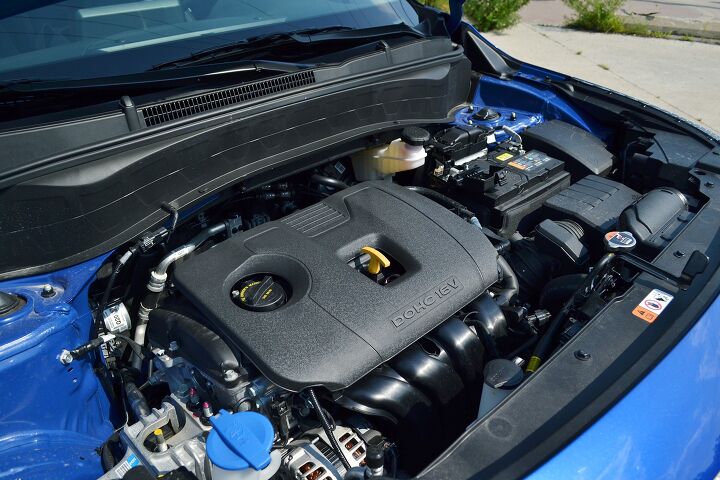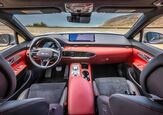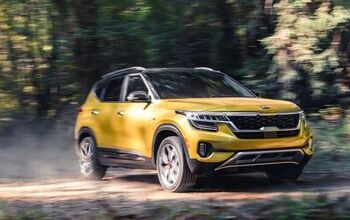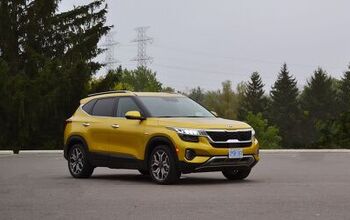2021 Kia Seltos EX Review: Where Do Its Priorities Lie?

FAST FACTS
| Engine: | 2.0L I4 NA |
| Output: | 147 hp, 132 lb-ft |
| Transmission: | CVT, AWD |
| US fuel economy (MPG): | 27/31/29 (claimed) |
| CAN fuel economy (L/100KM): | 8.8/7.6/8.2 |
| Starting Price (USD): | $23,110 (inc. dest.) |
| As-Tested Price (USD): | $26,410 (inc. dest.) |
| Starting Price (CAD): | $24,790 (inc. dest.) |
| As-Tested Price (CAD): | $29,779 (inc. dest.) |
Kia’s new sub-compact crossover has an uphill battle on its hands. Can it prevail?
The general quality of cars has risen tremendously over the past decade and a half. We are at a stage in the history of the automobile where there are no more “bad cars”. This has made the job of an automotive journalist quite difficult. Now we actually have to put in the work and look at the finer points, because everything just works.
Get a Quote on a New Kia SeltosBut the whole rise in quality has also brought something unique to the fore: the focus. The sub-compact crossover segment where the 2021 Kia Seltos sits is fraught with options. But instead of what works and what options are available today, the question is what the car does best. Is it a highway cruiser, a city slicker or a corner carver? That is the question we attempt to answer with the Kia Seltos EX 2.0—so let’s start with where you’ll spend the most time.
The Spacious Cabin
The Seltos’ boxy shape frees up an ample room inside, and you never feel constrained despite the tiny sunroof. Plus, even taller passengers will have ample headroom in the rear bench thanks to the high and squarish roofline. According to dear wifey, the seats are more comfortable than more expensive crossovers. Those of slightly wider proportions, like yours truly, will feel snug without feeling uncomfortable. The addition of lumbar adjustment could have added to the comfort though.
We had the EX trim as our tester. It sits in the middle of the lineup overall, and at the top of the trims with the 2.0-liter engine. Despite being the top dog in the 2.0-liter lineup, it is devoid of electrically adjustable seats and soft-feel plastic. Though the plastic on the dash feels of adequate quality, you do feel that you are in a budget car.
The steering wheel is (faux) leather-wrapped and feels nice to hold but it also further enhances the contrast between what you get and what you miss. The rear bench, as we said before, is quite spacious but the seat backs could be more supportive. You constantly feel you are spilling out of them despite the sizeable shoulder width of 54.7 inches. One of the gripes—rather a nitpick—is that door pockets are a tad too small to hold one-liter metal bottles. They do however fit into the cup-holders without a problem, so you will have to choose wisely between your cuppa joe and the water.
The trunk space is massive. I would go into the exact measurements but it is almost square barring the wheel arches that protrude into the trunk. It easily swallowed my three-year old’s stroller and bicycle along with half a week’s worth of groceries so that’s quite impressive.
Is the 8.0-inch Screen Enough?
Surprisingly, yes. The infotainment screen isn’t groundbreaking but is adequate and honestly, better than the one on some crossovers from a segment above (I’m looking at you, RAV4). The screen resolution is sharp, and the interface is smooth.
SEE ALSO: 2020 Toyota RAV4 Hybrid Review: The Dependable OneYou can customize the home screen but the interface itself isn’t intuitive. The buttons on the sides really help in quick navigation. Speaking of, there is no in-built navigation so you will have to rely on the navigation from Android Auto and Apple CarPlay, both of which are standard. Both work quite well but Apple CarPlay is smoother. If you have the map and Spotify on at the same time the system tends to lag at times, though. I really like the star button, which lets you assign any function you want to it.
City-friendly Ride
Let’s start with the city. The ride is supple and very comfortable. You can tell the suspension is soft sprung but not overtly so. It tackles undulations and deep manhole covers that seem to litter the city streets with ease. Even if you hit them at 35 mph you get barely a thud and just don’t feel it. Even staggered rumblers don’t unsettle the car, provided you do slow down for them. Body roll is minimal and even the sharper turns at sedate speeds do not upset the balance of the Seltos. The cabin too is fairly quiet and NVH levels are adequate for the city as not much sound filters into the cabin unless you’re passed by a loaded semi.
Get on to the freeway however, and things, unfortunately, fall apart a bit. The moment you cross 50 mph, the tire roar simply switches on. It sounds like someone turned the dryer on right beneath your feet and forgot to turn it off. The wind noise increases too, and it becomes hard to drive with no music on. Plus, given the Seltos’ almost square side profile and relatively low weight, it’s easy picking for a strong wind draft. It simply doesn’t feel comfortable on a highway. It gets jittery especially when changing lanes and a bit jumpy when you hit undulations on the freeways. You will almost always feel stressed on the freeway and relieved when you get off them.
On-road Manners
One of the most remarkable things about the engine is the instantaneous start-up. Thumb the starter and the engine come to life instantly. It’s almost like an electric car except, you know, the engine noise, of which there is plenty. Though the cabin is fairly quiet, if by any chance you have your window down, you will hear it. And from the outside, it doesn’t sound nearly as refined as you would expect—it’s rather clattery.
The engine pairs with a continuously-variable transmission with all-wheel drive. Kia calls their CVT the IVT or the Intelligent Variable Transmission and with good reason. It has an eight-step ratio system and it goes through its virtual ratios exactly like an AT would. It makes gearshifts (between virtual ratios of course) feel more organic than a conventional CVT. Rolling off the line is no problem and just like the suspension setup, the CVT feels completely at home in the city. Although easy-going, you don’t feel the four-pot is lacking in power or grunt. But it is not the one for quick overtakes. The transmission is sedate too: it responds well to throttle inputs but sudden changes throw it off its balance. You will miss the overtake window because the transmission couldn’t shift down its ratios fast enough. Dial the enthusiasm back a bit and the transmission responds well—and you tend to cover ground more quickly—but the urgency you sometimes might require is lacking.
The engine makes 147 hp and 132 lb-ft of torque which, while adequate in the city feels, not so on the freeway. There is virtually no grunt in the lower half of the rev-range. Nothing happens before 3,000 rpm at highway speeds. Plus, since it has eight ratios, the seventh and eighth are essentially overrides. Even while coasting, the gearbox usually seats itself in sixth unless you go for the manual override which can be used for coasting only. Sitting in eighth I mashed the pedal to the carpet to analyze the results and literally, nothing happened. It was a similar case in seventh but at least there was gradual progress.
When you do want to accelerate you will have to drop down to fifth to make up ground at highway speeds which means constantly edging over the 3,500 rpm mark. That’s when the Seltos starts to cover ground but also severely affects the fuel economy. After 250 miles evenly distributed between city and highway the Seltos returned 25.8 mpg overall which isn’t exactly impressive. If the car is fully loaded with four adults and a child on board, it tends to feel even more underpowered and almost bogged down by the weight.
A Sharp Suit But Not Tailored
In profile, the Seltos looks quite SUV-like, more so than a lot of its competitors, which stay true to their crossover roots.
The Seltos sports the conventional two-box SUV styling with a square face, a relatively steeply raked windshield, a roof that doesn’t swoop downwards, and a tailgate that is just that. The sleek DRLs and the tiger nose grille stands out in a crowd and a brighter color than the one we had will certainly turn heads.
Another quirky design element is the tiger-nose-esque kink in the windshield that lines up perfectly with the grille and lends the front a unique look. The tail lamps are far from unique though. If you were to remove the badges, anyone would be hard pressed to discern what it was that was holding up the fast lane on the freeway.
Pocket Impact
The Kia Seltos starts from $23,110 for the base LX trim, ($24,790 in Canada). The one we got for our test was the EX trim which starts from $26,410 ($29,390) before options. The EX is the top 2.0-liter trim; beyond that you’re in turbo territory. Going above the EX trim the S and SX trims are priced from $26,690 and $29,010 ($34,390) respectively. By comparison, the Toyota C-HR, only available in front-drive form, starts from $22,620 ($25,590) and the Mazda CX-30 with AWD starts from $24,400 ($28,000). Though the Mazda is more powerful and also more expensive, with the Seltos you get a lot of car for your money.
Verdict: 2021 Kia Seltos EX Review
There is no doubt that the Seltos, especially with the 2.0-liter engine, is strictly an urban dweller. It rides well in the city and has a trunk large enough for groceries and your kid’s school supplies to coexist with ease. Out on the highway though, it feels nervous and out of its element. So, if you drive mostly in the city, virtually never venturing out on the highway, and want something that is compact, comfortable and easy on the pocket, the Seltos 2.0 is the ideal car.
Become an AutoGuide insider. Get the latest from the automotive world first by subscribing to our newsletter here
LOVE IT
- Spacious cabin
- In-city road manners
- High level of comfort
LEAVE IT
- Engine lacks power
- Overuse of hard plastic
- Highway ride

More by Kshitij Sharma









































Comments
Join the conversation